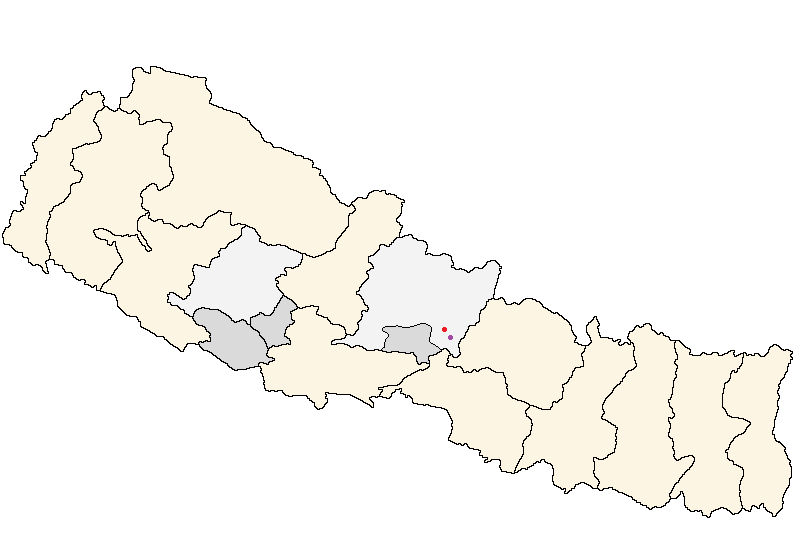Native to Nepal Ethnicity 160 (no date) Language family Language isolate | Region Gandaki Zone Native speakers 3 (2017) ISO 639-3 kgg | |
 | ||
Kusunda (Kusanda) is a language isolate spoken by a handful of people in western and central Nepal. It has only recently been described in any detail.
Contents
For decades the Kusunda language was thought to be on the verge of extinction, with little hope of ever knowing it well. The little material that could be gleaned from the memories of former speakers suggested that the language was an isolate, but without much evidence either way it was often classified along with its neighbors as Tibeto-Burman. However, in 2004 three Kusundas, Gyani Maya Sen, Prem Bahadur Shahi and Kamala Singh, were brought to Kathmandu for help with citizenship papers. There, members of Tribhuvan University discovered that one of them was a fluent speaker of the language. Several of her relatives were also discovered to be fluent. There are now known to be at least seven or eight fluent speakers of the language, the youngest in her thirties. However, the language is moribund, with no children learning it, as all Kusunda speakers have married outside their ethnicity.
Watters (2005) published a mid-sized grammatical description of the language, plus vocabulary, which shows that Kusunda is indeed a language isolate, not just genealogically but also lexically, grammatically, and phonologically distinct from its neighbors. It appears that Kusunda is a remnant of the languages spoken in northern India before the influx of Tibeto-Burman- and Indo-Iranian-speaking peoples, however it is not classified as a Munda or a Dravidian language. See also Burushaski, Nihali and (potentially) the substrate of the Vedda language for other Indian languages which don't fall into the main categories of Indo-European, Dravidian, Tibeto-Burman and Australasian.
Vowels
Phonetically, Kusunda has six vowels in two harmonic groups, which are arguably three vowels phonemically: a word will normally have vowels from the upper (pink) or lower (green) set, but not both simultaneously. There are very few words that consistently have upper or lower vowels; most words may be pronounced either way, though those with uvular consonants require the lower set (as in many languages). There are a few words with no uvular consonants that still bar such dual pronunciations, though these generally only feature the distinction in careful enunciation.
Consonants
Kusunda consonants seem to only contrast the active articulator, not where that articulator makes contact. For example, apical consonants may be dental, alveolar, retroflex, or palatal: /t/ is dental [t̪] before /i/, alveolar [t͇] before /e, ə, u/, retroflex [ʈ] before /o, a/, and palatal [c] when there is a following uvular, as in [coq] ~ [t͇ok] ('we').
In addition, many consonants vary between stops and fricatives; for instance, /p/ seems to surface as [b] between vowels, while /b/ surfaces as [β] in the same environment. Aspiration appears to be recent to the language. Kusunda also lacks the retroflex consonant phonemes common to the region, and is unique in the region in having uvular consonants.
[ʕ] does not occur initially, and [ŋ] only occurs at the end of a syllable, unlike in neighboring languages. [ɴʕ] only occurs between vowels; it may be |ŋ+ʕ|.
Pronouns
Kusunda has several cases, marked on nouns and pronouns; here we illustrate three, nominative (Kusunda, unlike its neighbors, has no ergativity), genitive, and accusative persons.
Other case suffixes include -ma "together with", -lage "for", -əna "from", -ga, -gə "at, in".
There are also demonstrative pronouns na and ta. Although it is not clear what the difference between them is, it may be animacy.
Subjects may be marked on the verb, though when they are, they may either be prefixed or suffixed. An example with am "eat", which is more regular than many verbs, in the present tense (-ən) is,
Other verbs may have a prefix ts- in the first person, or zero in the third.
Long-range comparisons
Before the recent discovery of active Kusunda speakers, there were several attempts to link the language to an established language family. B. K. Rana (2002) maintains that Kusunda is a Tibeto-Burman language as traditionally classified. Others have linked it to Munda (see Watters 2005); Yeniseian (Gurov 1989); Burushaski and Caucasian (Reinhard and Toba 1970; this would be a variant of Gurov's proposal if Sino-Caucasian is accepted); the Nihali isolate in central India (Fleming 1996, Whitehouse 1997); and again with Nihali, as part of the Indo-Pacific hypothesis (Whitehouse et al. 2004).
None of these proposals took Watters' more recent data into consideration, and none is widely accepted. Kusunda pronouns do resemble those of the languages of the Andaman Islands and West New Guinea: Compared to Juwoi, we have tsi (likely from *ti) vs. tui "I", tsi-yi (*ti-ye) vs. tii-ye "my", nu vs. ŋui "thou" (Kusunda has no initial ŋ), ni-yi (*ni-ye) vs. ŋii-ye "thy", gi-na "that" vs. kitɛ "this". (See a summary here.)
